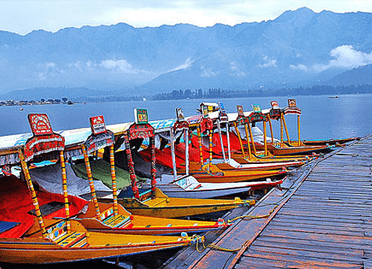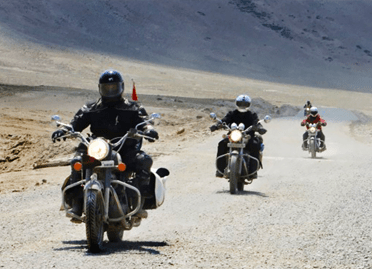Where am I : India Tour Packages » Most Popular Packages » Kargil Tour Packages
View Details

Destinations Covered : » Gulmarg » Sonmarg » Kargil » Leh » Khardongla Pass » Nubra Valley » Leh
View Details

Destinations Covered : » Gulmarg » Sonmarg » Kargil » Leh » Khardongla Pass » Nubra Valley » Leh
Kargil Tour Packages
Suru Valley, a gorgeous location where travellers may absorb in the clean atmosphere of the serene surrounds, is one of the most famous tourist attractions. During the tour, you may stop by the Kargil War Memorial to see examples of Indian troops' bravery and fortitude. Mulbekh Monastery is said to have been constructed about the year 800. The monastery consists of two gompas, Serdung and Rgaldan-se Gompa. Kargil is not only a haven for nature lovers, but it's also a great destination to come for adrenaline seekers looking for exciting activities. During the Kargil tour, adventurers can climb the Nun Kun massif and the Nun Kun massif. Mountaineering in Kargil is best done between July and September when the weather conditions are still suitable. Kargil tour packages are custom-made, and you may build your vacation to your specific needs. Travel professionals can assist you in planning a great Kargil vacation in conjunction with a Ladakh tour.
History of Kargil
Kargil has a population of 1.25 lakh people and covers an area of 14,086 square kilometers. It is located 205 kilometers from Srinagar in the direction of Leh. In today's world, Kargil is known as the Agas Land. It's because Kargil is mostly populated by Shia Muslims, and Agas are the religious leaders and speakers. Kargil is a combination of the terms Khar and rKil. As the site sat between numerous kingdoms, Khar means castle and rKil means centre, making it a place between castles. Many critics believe that the term Kargil is formed from the words Gar and Khil. Gar means 'Anywhere,' and Khil refers to a central location where people can stay. This is supported by the fact that the location is around 200 kilometers from Srinagar, Skardo, Leh, and Padum. Khar rKil or Gar Khil became known as Kargil with time. According to contemporary official and historian Parvez Dewan's contribution to the book "Kargil Blunder," a pioneer named Kargeel cleared the woods in the Poyen and Shilikchay area before the arrival of Thatha Khan, and the area finally received its name.
Gasho Tha Tha Khan is claimed to be the first well-known crusader in the area to establish a dynasty. Tha Tha Khan was a member of the Gilgit royal line that conquered Kargil in the early eighth century. His dynasty governed the Sod region of Kargil in the early days until settling permanently in Shakar Chiktan, where the dynasty still exists now. The Kachos of Kargil is thought to be Tha Tha Khan's offspring. Purik Sulatan was a great Kargil builder who founded his realm in Suru and governed from Karchay Khar near Sankoo. The territory of Kargil was governed by Kunchok Sherabtan of Fokar, Kalon of Mulback, and various Kachos, Sultans, and Maqpons of Sod, Pashkum, Wakha, Chiktan, and Karchey, who enlarged their kingdoms to be integrated with the State of Jammu and Kashmir. On October 31, 2019, Ladakh became a Union Territory, and Kargil became part of the Ladakh Union Territory.
Purik was the old name for the majority of what is now Kargil. Tibetan academics gave this appellation since the people who live in this section of the country exhibit Tibetan characteristics. The Dard people live in Drass, and the Ladakhi – Tibeto people live in Zanskar. Aryans, Dards, Tibetans, and Mongoloids are the racial stocks of Kargilis. Kargil is a location where people of all ethnicities, languages, and cultures coexist. Brogpas, Baltis, Puriks, Shinas, and Ladakhs are the many ethnic groups. Shina, Balti, Purig, Ladakhi, and other languages are spoken. Urdu is widely spoken in the area since the Balti and Shina languages are written in Urdu script. In the 15th century, Islam arrived in Kargil. Mir Shams-ud-Din Iraqi, a Central Asian Shia scholar, preached Islam in Baltistan and Kargil alongside his missionaries. The Baltistan chief was the first to accept Islam, followed by the Kargil chiefs. Before Mir Shams-ud-Din, Iraqi Khawaja Noorbaksh traveled to Kargil and preached Islam. As a result, Buddhism was restricted in Kargil to locations such as Sapi, Phokar, Mulback, Wakha Bodh-Kharboo, Darchik Garkon, and Zanskar. Kargil was separated from the erstwhile Leh district in 1979 and became a distinct district in the Ladakh area. The Kargil district's Ladakh Autonomous Hill Development Council was established in July 2003. The Ladakh Autonomous Hill Development Council has 30 members, with 26 being elected and the remaining four being nominated. The district of Kargil is divided into nine administrative blocks.
Why will you love Kargil?
Most of us like traveling, but hectic living schedules, work, and obligations keep our main plans on hold, causing most of our plans to be canceled at the last minute or not planned at all. Going far away to the mountains or on a beach holiday necessitates taking four to five days off work, which is not realistic for most of us, and neighboring places don't provide us with nearly as much joy.
Kargil, on the other hand, is a location that is well accessible to all major Indian towns and requires only a weekend or three days to visit (yes, we mean a long weekend). This unique destination provides all you might desire for a mountain vacation: multicolored places, scenic valleys, strange lakes and rivers, boulder walking, camping spots, and so on. Plan your entire journey to Kargil in only a few days to get away from the monotony of city life.
Historical Monuments in Kargil
Kargil was once known as Purig. Kargil was formerly made up of numerous tiny kingdoms like as Pashkum, Chitkar, Fokar, Soth, and others. Despite their modest size, these kingdoms had a strong predisposition to fight over little matters. Gasho, also known as Tatha Khan, is supposed to have brought all of these kingdoms together under one governance.
Furthermore, it is stated that Ali Sher Khan Anchan had a significant impact on this particular geographical area throughout his reign. With time, the Dogra people ultimately succeeded in uniting Baltistan, Purig, Zanskar, and other regions in the first part of the nineteenth century.
Sani Gonpa
This castle-like monastery is located 7 kilometers before Padum and, unlike other Ladakh monasteries, is built on flat ground. The Kanishka Stupa, which lies in the walled complex's rear, is said to be related to Kanishka (Kushan monarch of the 2nd century AD), according to tradition.
War Memorial of Drass
Being a war-torn territory, it's easy to assume there won't be much to see and explore. On the contrary, owing to the growing tourist throngs in the major conflict theatre, several hotels have been built up here in the past. It's also clear that the place's whole dynamics have transformed, which is nice to witness and feel.
Karsha Gompa
This is Zanskar's largest monastery complex, located 9 kilometers from Padum. The majestic complex of white-washed structures may be observed from Padum. 150 monks, eight temples, two assembly rooms, precious icons, artifacts, manuscripts, and thankas are all housed in this compound. The monastery dates from the 14th century.
Monastery of Burdan
An isolated monastery located atop a rock rising steeply from the river 12 kilometers from Padum, in the Lungnak valley, maintains a significant position among the Drogpa order monasteries of Zanskar. Deba Gyatso established it in the early 17th century. However, it is most known as the home of Lama Barapa.
Bhembat
A prominent Hindu mythology location 5 kilometers from Drass is where a rock sculpture is said to be the solidified body of Bhim.
What are the top fascinations to visit in Kargil?
Sankoo
Suru Valley is a picturesque place with a lush landscape and dense plantations located 40 kilometers from Kargil town. It is also the starting point for a four-day trip to Shargole through Rusilla and Sapi and a three-day pleasure trek to Drass via Umballa. The neighboring Bamiyan Type Rock monument is well-known.
Rangdum
A beautiful camping spot in the Himalayan environment and complete seclusion may be found 130 kilometers from Kargil on Padum road. The major draw here is an enormous 18th-century monastery situated picturesquely on a hillside like an old fort. Rangdum also acts as a starting point for other trekking routes.
Rzong Fokar-Urgiyan
The cave Hermitage of Urgiyan Rzong, Guru Padma Sambhava's famed meditation retreat, is located in a Fokar side valley about 8 kilometers upstream from Shargol. The hermitage is hidden behind a magnificent natural mountain fort. Here you may see the handprints of this renowned saint as well as some other natural figures. Devotees gather here on the 10th day of the 5th Tibetan month to commemorate the Guru's birth.
Monastery of Shargole
Shargole lies another 10 kilometers ahead of Mulbekh, or 35 kilometers before Kargil, with its modest but remarkable Ge-Lugs Pa Buddhist monastery. An Avalokiteswar icon may be seen within the Gompa. Three representations of Tara, caved in wood by Tibetan craftsmen, may also be found in the Gompa. It looks to be floating in the center of the mountain, emerging from a brown granite wall. It is also a source of fascination for locals due to its unusual architecture. The panoramic view from the "cantilever monastery's" verandah is breathtaking and aids in worshipper concentration. Below is a little Buddhist nunnery.
Phoker
The Shargole Monastery is 4 kilometers ahead of Phokar (also Fokar). A towering hill dominates the Phokar plain. To go to the Phokar Rizong / Urgyang Dzong, you'll have to climb it. Because the Rizong has certain unique properties, it appears that one may meditate with better focus there. One such location is the Phokar Rizong. It is made up of a circular flat plain surrounded by hills and caves, with a modest temple in the center. It is reported that prominent Buddhist saints, including Padma Sambhava, meditated in these caverns. There are two ways to go to the Rizong from the plain. The subterranean journey is substantially shorter, at roughly 1 km. This road will be unusable when the snow melts in June and July, so you'll have to take the longer (3-4 km) path instead.
Monastery of Mulbekh
The 9-meter tall Maitreya Buddha image carved into the rocks is breathtaking. Seeing such a lovely idol is an unforgettable experience for each tourist. This location features two Gompas, which may be seen when exploring it. Drukpa and Gelugpa are the two schools of Tibetan Buddhism. These Gompas are linked to Raja Kalon of Mulbekh's neighboring palace. Mulbekh Monastery is regarded as one of Ladakh's finest monasteries.
Main Street in Kargil
The main street in Kargil isn't exactly shopping heaven. However, you may expect some excellent shopping opportunities, such as dried fruits and handicrafts. Furthermore, there are a few businesses where you may purchase locally created folk music as mementos.
Trekking
Trekking is a fantastic activity for sports enthusiasts to partake in here. For first-time hikers, though, this may be a difficult experience. So, my humble suggestion to first-timers is to prioritize their safety and obey the instructions of their guides.
Baroo Khanqah
This Khanqah, located 5 kilometers from the center of Kargil town, is highly well-known and renowned across Ladakh, and visitors flock to it all year. During the reign of Hazrat Syed Muhammad Nur Bakhshi or Hazrat Mir Shams-ud-din Iraqi, the Khanqah was constructed.
Suru Valley
Visiting the Suru Basin is a fascinating adventure. Apart from that, the Suru Basin features a lush green landscape and some of the most beautiful sights to enjoy.
Tip for those who are going on a Kargil tour
Kargil may be visited at any time of year, however, you must be prepared for your visit according to the season. Here are some Kargil travel recommendations to help you plan your trip to Kargil, Ladakh.
- If you're visiting Kargil in the winter, make sure you're dressed warmly and have the proper boots, gloves, and hat.
- Whether it's winter or summer, you'll need a nice pair of sunglasses.
- Be prepared for Acute Mountain Sickness (AMS) and take all precautionary steps; while this may not be a concern in Kargil due to its height, if you are traveling via Leh, you must be prepared for AMS.
- Take a longer and gentler tour of Kargil to get a complete understanding of the place and its rich culture.
- Currently, there are few places to stay in Kargil during the winter months, although this is changing as the town develops as a winter attraction.
Where to stay in Kargil
There are several hotels in Kargil from which to explore the area. Not all hotels are open in the winter, but as Kargil grows, more alternatives will become available. In Kargil, there are a few great hotels to stay at:
- Hotel The Kargil
- Rangyul Resort Kargil
- PC Palace Kargil
Cleartrip, TripAdvisor, Agoda, Makemytrip, and Priceline are all good places to book a hotel in Kargil or Leh.
How to get it?
By Air
The nearest airport to Kargil is Leh Airport (IXL), also known as Kushok Bakula Rimpochee Airport. It is also one of India's most picturesque airports, at a height of around 3,256 meters. It has an excellent connection to the rest of India. After disembarking from your aircraft, you can hail a cab or use other local transportation alternatives to go to your destination.
By ROAD
Motorable road networks connect Kargil to the rest of the world. The road distance between Srinagar and Kargil is approximately 202 kilometers. Regular buses run from surrounding cities like Srinagar and Jammu. If it is more convenient for you in terms of travel and expenditures, you might easily drive to this location from major cities.
- 123 kilometers along NH1 from Sonmarg
- 465 kilometers via NH44 or NH1 from Jammu
- 202 miles along NH1 from Srinagar
By Train
Jammu is home to the closest railway station. Traveling to Jammu by rail is an unforgettable experience. Overall, it has a decent connection to other Indian cities. It is, however, around 450-500 kilometers from Kargil. To go to your destination, you'll need to take a cab or a bus from the station.
Rental cars services in Kargil
Discover Kargil, Jammu, and Kashmir, India, by renting a vehicle at Chulichang. Chulichang car rental provides affordable rates and a large selection of automobiles. You may compare offers from major cars rental companies such as Avis, Europcar, Sixt, and Thrifty and budget rental companies such as Holiday Autos, Budget, Economic, EasyCar, and 121 car hire. Choose a vehicle rental company in Chulichang that meets your needs. Everyone should be able to choose a car that is suitable for their stay in Kargil, Jammu, and Kashmir, India.
Kargil Important instructions when you rent your car
Before you start the engine of the automobile you hired in Chulichang for the first time, make sure it meets the contract's requirements. Check the gasoline level in the tank in particular. It should be full; if not, request a fuel refill or a revision in the contract parameters. Remember to inspect the vehicle's body for any problems in the paint, wheel discs, or other visible elements.
Policy on Fuel
The general guideline is: pick up full, return full. This implies you should take up the automobile with a full tank of gas and return it with a full tank of gas. Some suppliers will charge for this service at first but will refund the price if the petrol tank is full when you return (otherwise you will be charged for the missing). Because fuel policies are subject to change, please confirm with the provider in Chulichang.
The Driver's Age
You will be questioned about your age throughout the booking process (see the form above). The premium for teenage drivers may not be included in the rental price, so check the pricing details (then it is to be paid at the Chulichang rental desk in the local currency). Young drivers may be charged an additional cost since they typically cause more automobile accidents. Depending on the country and location, the minimum driving age ranges from 16 to 21 years. Chulichang's car provider would be pleased to help you fulfill your local Kargil, Jammu, and Kashmir, India needs.
Another Driver
You can add extra drivers to your reservation. To sign the rental agreement, all extra drivers must be physically present at the Chulichang rental counter with their individual driver's licenses at the time of rental. Depending on the rate circumstances, an extra driving fee may be levied, which must also be paid at the counter. Additional driver authorization is usually available upon arrival for a modest fee per person per day.
Your booking voucher will include information on extra drivers. This area also displays any additional items you have purchased, such as infant seats and booster seats. These extras are normally not included in the listed price and must be paid for separately upon arrival.
Specify your request and receive prices
Begin your search by entering your pick-up location in the box above: Select your preferred vehicle type and input your pick-up and drop-off dates. Select the search option.
Select the best offer for you
A quotations list will be supplied. Choose your preferred deal. To see the rental terms pertaining to the relevant quotation, click the "rate information" link. Vehicle to vehicle, nation to country, and supplier to supplier, and the circumstances may differ. The offer details will emerge when you move your mouse over the included sign above the pricing information. Select the book option.
Make a reservation and receive fast confirmation
Enter your credit card information to complete your reservation. The connection is safe and encrypted. You will get your car rental voucher, which will include the booking information as well as directions on how to pick up the vehicle.
Mileage restriction
Some automobile rental companies may impose limits on how far you may go in a single day; see the tariff details for more information.
Speak to our Experts!
Instant Quote, Best Deals - 100% Customizable, Includes hotels + car + guides Cost depends on various factors like, number of people you are, travel dates, category of hotel and transportation etc.Drop your Inquiry to get the best deals as per your requirements. 100% Satisfaction Guaranteed. Rated 5* in TripAdvisor.Loading...




